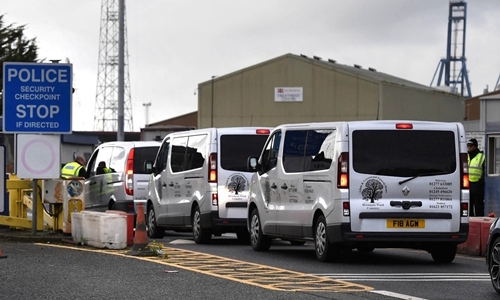The organization pays attention to features such as moles, tattoos, and fingerprint collection and DNA collection.
Eleven of the 39 bodies in the container in Essex were taken to Broomfield Hospital in the town of Chelmsford on October 24 to identify and examine the cause of death. The remaining bodies are expected to be completed by the end of the week.

A convoy carrying bodies from Tilbury port to Broomfield hospital on October 25 Photo: Reuters
The Essex County Police initially believed that the victims, including 31 men and 8 women, were Chinese, but officials investigating suspected victims had other nationalities. The Chinese embassy in London sent staff to Essex to verify the situation, but the victims' nationality could not be determined. Vietnam supports the UK in speeding up the victim identification process, according to the October 25 statement of the Ministry of Foreign Affairs.
The first step to identity is to seek indirect evidence, says Dr. Noemi Procopio, a forensic science lecturer at Northumbria University, Newcastle. These are items on or around the body that can give clues about identity including clothing, furniture and documents, but they are not enough to prove who they are.
"For example, clothes can be transferred from person to person," she said. "These items may be important but cannot be used to prove their identity, they are just the first clues."
The next step is visual recognition, but this depends on the condition of the body, which can vary significantly depending on the condition. The body begins to decompose as soon as the heart stops beating, enzymes released in the body disintegrate surrounding cells and tissues. "This can change the face shape a lot in a fairly fast time," Dr. Procopio said.
If still at an early stage, facial recognition can be done by taking photos, sending it to relatives or friends, although this stage still cannot prove identity.
Signs like scars, tattoos or other characteristics are "a more reliable way to identify," Procopio said.
The next stage is biometric identification, beginning with the simplest method of fingerprinting (although this still depends on the condition of the body). Fingerprints exist as long as there is soft tissue, maybe for a few days or even a week.
"The advantage of fingerprints is that you can have specific and reliable information, not subjective," Procopio said.
In addition to determining how and how long a person has died, autopsies can also provide identity through bone and dental data. "If you have a fracture, your bone will have certain characteristics a few years later," she said.
However, this method requires data records to compare characteristics. There is also much debate about the reliability of bone and teeth check. Although they are not heavy enough compared to other alternatives, they can still be very helpful.
DNA can be obtained from various tissues, from "biological fluids" such as blood and saliva to meat, hair, organs and bones. It can help identify relatives up to 3.4 generations away. The process of DNA determination depends on whether a relative or family member is willing to be tested, or whether their DNA has been stored in a database before.
"DNA is the most powerful identification tool," Procopio said. Collecting DNA data can take two days, while the amount of time it takes to find a match in a database depends on the country where the database is held.
"My experience is that it is possible to test DNA within a week," Procopio said.
The Essex police on October 25 posted a notice on the website, saying the identification and autopsy process could be lengthy but insisted it was "very important". We are working with an extraordinary death investigation official to ensure that respecting the victims and their relatives is paramount, "Essex police said.



 TravisJStrachan
TravisJStrachan







